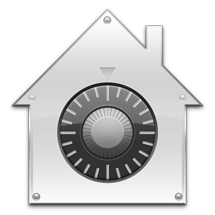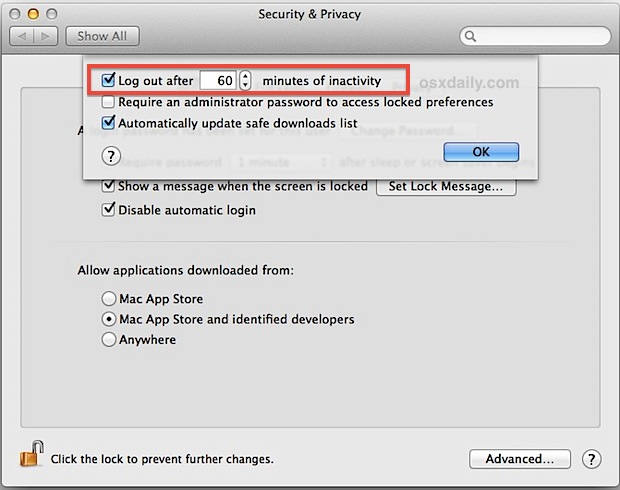Automatically Log Out of a Mac After a Period of Inactivity
 Using the automatic log out feature is a good way to bring an additional layer of security to a Mac. It works just as you’d expect; after a predetermined amount of time has passed without activity, the active user account logs itself out. This means all currently running apps close out as well as all documents which save in their current state through the Versions & Resume features. Then, in order to use the Mac again, someone will have to log back in with appropriate user and password credentials, thereby preventing unauthorized access. And of course because of the relatively new OS X Resume feature, once you do log in again all of your past apps and documents will launch again where you left off.
Using the automatic log out feature is a good way to bring an additional layer of security to a Mac. It works just as you’d expect; after a predetermined amount of time has passed without activity, the active user account logs itself out. This means all currently running apps close out as well as all documents which save in their current state through the Versions & Resume features. Then, in order to use the Mac again, someone will have to log back in with appropriate user and password credentials, thereby preventing unauthorized access. And of course because of the relatively new OS X Resume feature, once you do log in again all of your past apps and documents will launch again where you left off.
As we’ll mention, this is best used in conjunction with the standard Mac lock screen trick that utilizes the screen saver and can be activated through a keystroke, and should not be considered a replacement for that unless the inactivity time is set very aggressively or there is some other unique circumstance.
Set Up Automatic Log Out in Mac OS X
Automatic log out is easy to overlook, but it’s also very easy to configure:
- Go to the Apple menu then launch System Preferences
- Choose “Security & Privacy”
- Click the “General” tab, then choose the “Advanced” button in the lower corner
- Check the box next to “Log out after _ minutes of inactivity” and set your time limit

The default setting is 60 minutes, which is fairly generous but also allows for reasonable time to pass, like a lunch break or whatever else.
Combine with Automatic Login Prevention
While you’re in the Security & Privacy control panel, be sure to disable automatic login as well by unchecking it under the “General” tab. That way any user will be required to login with a user account with full credentials and a password – even if they reboot the computer – just remember to have the Guest account configured so that you will gain the Find My Mac protection offered through it in the odd event the computer is stolen, making it trackable from the web, another Mac, or iOS device that has Find My iPhone installed.
Use with a Locked Screen Saver for Better Security
While this is a great security feature, using this alone should not be considered adequate for keeping your Mac safe from unwanted user access. For Macs that are in public, offices, schools, or elsewhere where others may gain access to the computer, you should always set the screen saver to activate with a password thereby locking down the Mac screen. The lock screen method in Mac OS X will then cover the shorter periods of inactivity of just a few moments away from a desk, and also remains a quick way you can manually activate the passworded screen by invoking an appropriate keyboard shortcut, while the more inclusive automatic log out will cover longer periods away from the desk.
Automatic Log Out vs Locked Screen Savers
If you’re wondering what the difference of these two similar features are, here’s a brief explanation of each and how they’re different.
Automatic Log Out will close applications and documents of the logged in user, while saving the last state of OS X so that everything will resume back to where it was once the user is logged again. This frees up system resources for other users, and allows other users to log into the computer if it’s multi-use.
Screen saver locks only bring a protective layer over current actions and don’t log anything out, all apps continue to run in the background and documents remain open. Because the user stays logged in, it does not free up resources by closing out apps of that user, and it also does not allow another user to login to the Mac.
In short, the screen saver approach is perfect for quick away-from-keyboard moments, while the automatic log out is better for extended periods away from a desk, particularly in corporate or educational environments.


You are a life saver. that´s the issue!
This did not work for me either. I have it set for 4 hours yet in a few minutes I look up and I’m logged out. Really annoying as I am a teacher and it has disrupted my classes. Moving back to a PC. Apple screws WAY too much up with software updates. They hide all kinds of changes that I do not want and then there is no way to change to correct the issue. This is a shining example. They will not stop until people walk away from them which will never happen. Nothing will happen unless there are consequences for their bad behavior. They could give a rats rear about the consumer. Take what we give ya or p** off. I choose to P** Off.
Thank you for the log in/ out issue. Your advise worked!
Is there a way to set this from the command line? I have far too many devices to do this by hand.
You write: “Combine with Automatic Login Prevention –
While you’re in the Security & Privacy control panel, be sure to disable automatic login as well by unchecking it under the “General” tab. ”
In my Mojave 10.14.3, the tick box should be “checked”, not “unchecked”.
This feature simply does not work – I cannot get it to work and I always apply every update
LockMeNow is a good app allows u
You to lock screen using keyboard shortcut. Can be found in Mac AppStore.
No need to buy an app when the feature is built into OS X